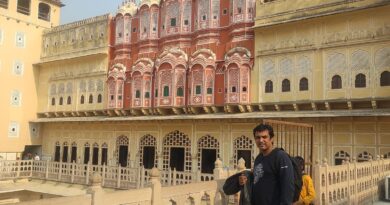Haridwar Cameos
The urgent tolling of temple bells sends a thrill of anticipation through the crowd of devotees and tourists that gathers each evening before sunset at Har-ki-Pauri, the main bathing ghat on the River Ganga as it flows through the pilgrim town of Haridwar, Uttarakhand. The scene is one of organized pandemonium: men stripped down to their underwear and women in dripping saris taking purifying dips in the rushing waters; people floating offerings of flowers burnt camphor and incense sticks in boats made of leaves; priests blessing newly wed couples; sadhus with flowing locks and hooded eyelids pulling on chillums; devotees filling the water of the sacred river in white plastic containers
Suddenly all activity around the ghats seem to freeze and everyone’s attention is on an idol of the Ganga which is brought out in a bright red palanquin carried by the temple priests. Once she is installed on the banks of the river the world reawaken and chaos rushed in to preside over the setting. Seeing the torrent of unadulterated devotion being poured into the surging river as it sweeps by, one starts to understand why Haridwar, more than any other place, is deemed to be the true home of the river Goddess Ganga. The popular belief is that it is at Haridwar that the holy river leaves the Himalayas (her parents home) and enters the plains of India (the home of her in-laws).
Haridwar is also the backdrop to the tragic story of Sati, the daughter of King Daksha who married Lord Shiva against her father wishes. The vengeful king responded by performing a sacred yajna or sacrifice to which he invited all the Gods and sages except Lord Shiva. An outraged Sati threw herself in the sacrificial fire. Today the Daksha Mahadev Temple complex on the banks of the Ganga is built on the spot where the traumatic cosmic drama had been enacted.
The pilgrims trail include Chandi Devi temple which seems to balance precariously on the highest ridge of Neel Parvat (Blue Mountain). From up here one looks down on Haridwar, nestled in the valley below and the grey-blue slash of river Ganga coiling out of the mountains and easing into the plains. Across the town and the river, on the summit of Bilwa Parvat is Mansa Devi Temple which houses two statutes of the goddess; one with three mouths and five arms and the other, with eight arms. Ropeways ferry visitors up to these two temples. The other important shrine in this pilgrim town is Mayadevi Temple.
Come evening and the entire town, or so it would seem, descends on Har-ki-Pauri to witness the Ganga arti. Indeed, Har-ki-Pauri is the setting of the Maha Kumbh Mela, one of Hinduism greatest festivals, when thousands of naked sadhus and pilgrims congregate here to have a purifying dip in the river Ganga.
The clanging of bells signals the start of the Ganga aarti and the priests who have been priming the oil wicks of the many layered lamps set them alight and start to swirl the flames in unison right across the face of the ghat. Indeed, the ballet of fire is a spontaneous happening, sustained by pure, untainted devotion and it captured the essence of the city – raw yet brilliant like an uncut diamond.
Fact File Haridwar is well connected by rail and road with the rest of the country. One may fly into Delhi and then take the early morning or afternoon Shatabdi to Haridwar.
Haridwar (along with neighbouring Rishikesh) is an important stop on the Char Dham pilgrim circuit of Badrinath, Kedarnath, Gangotri and Yamunotri. One can also mix pilgrimage with adventure and go white water rafting from one of the many camps further upstream.

